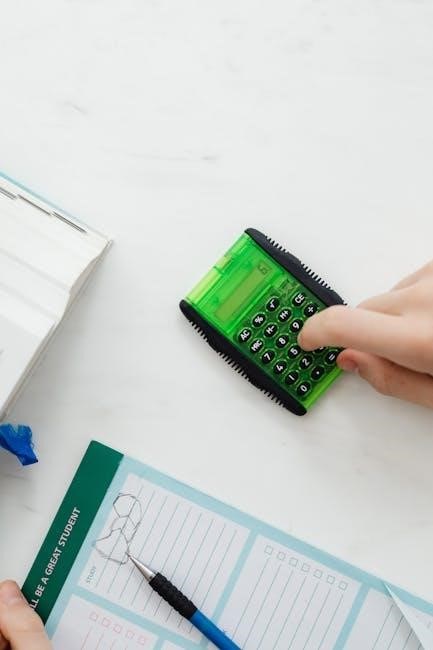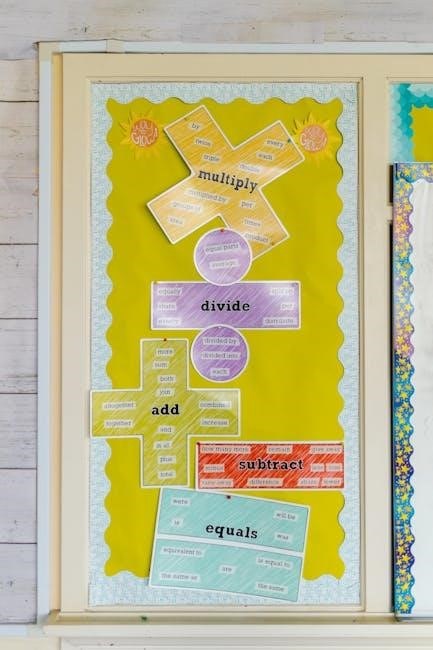Mastering integer operations is crucial for math proficiency. Our PDF worksheets offer a comprehensive guide, including multiple-choice questions, word problems, and visual aids to simplify learning.
What Are Integers?
Worksheets often include integers in various formats, such as word problems or number lines, to make learning engaging. By mastering integers, students develop problem-solving skills and critical thinking abilities.
Why Are Addition and Subtraction of Integers Important?
Addition and subtraction of integers are foundational skills in mathematics, essential for solving real-world problems. They help in budgeting, calculating temperatures, and understanding financial transactions. These operations are crucial in various fields like science, sports, and daily activities, where managing quantities and measurements is necessary. For students, mastering these skills builds a strong mathematical foundation, enhancing problem-solving abilities and preparing them for more complex concepts. Worksheets in PDF format provide structured practice, ensuring students can apply these operations effectively in diverse scenarios.

Key Concepts in Adding and Subtracting Integers
Mastering integer operations involves essential strategies like the number line method and the “Keep, Change, Change” rule. These concepts simplify adding and subtracting integers effectively.
The Number Line Method
The number line method is a visual approach to understanding integer operations. For addition, start at the first number and move right for positives or left for negatives. For subtraction, reverse the direction. This technique helps students grasp the concept of moving along a continuum, making abstract operations more tangible. Worksheets often include number line diagrams to guide practice, ensuring students can apply this method confidently across various problems. It’s a foundational tool for building fluency in integer addition and subtraction. Regular practice with these visual aids enhances problem-solving skills and reduces errors over time. This method is particularly effective for beginners, as it provides a clear, step-by-step process for achieving accurate results. By mastering the number line approach, students develop a strong understanding of how integers interact during addition and subtraction, preparing them for more complex mathematical concepts. The inclusion of number line exercises in worksheets ensures that students can apply this method consistently and effectively. As they progress, this foundational knowledge becomes instinctive, allowing for quicker and more accurate calculations. The number line method is also a versatile tool, applicable to both positive and negative integers, making it an essential component of any comprehensive worksheet on integer operations. Through repeated practice using this visual strategy, students can overcome common challenges and build a solid mathematical foundation. The number line method is widely regarded as one of the most effective teaching tools for introducing integer operations, and its integration into worksheets has proven to enhance student performance and understanding. By leveraging this approach, educators can help students develop a deeper appreciation for the logic behind integer addition and subtraction, fostering a lifelong love of learning and problem-solving. The number line method remains a cornerstone of integer instruction, providing students with a reliable and intuitive framework for tackling even the most complex operations with confidence and precision.
Rules for Adding Integers
Adding integers involves simple rules based on their signs. When adding two positive integers, the result is positive. For two negatives, the result is negative. Mixed signs require subtracting the smaller absolute value from the larger and taking the sign of the larger. Worksheets provide structured practice, ensuring mastery of these rules through various exercises. These exercises often include problems like 7 + (-5) = 2 and (-3) + (-4) = -7, helping students apply the rules confidently. Regular practice with these exercises builds fluency and reduces errors over time.
Rules for Subtracting Integers
Subtracting integers follows specific rules to ensure accuracy. The “Keep, Change, Change” method is a helpful approach: keep the first integer, change the subtraction to addition, and change the sign of the second integer. For example, 5 ⏤ (-3) becomes 5 + 3 = 8. When subtracting a larger integer from a smaller one, the result is negative. Worksheets often include problems like 7 ─ 4 = 3 and (-2) ⏤ (-5) = 3, reinforcing these rules. Regular practice with these exercises helps students avoid common sign errors and builds confidence in handling integer subtraction.
The “Keep, Change, Change” Method
The “Keep, Change, Change” method simplifies subtracting integers. To apply it, keep the first number, change the subtraction sign to addition, and change the sign of the second number. For example, 5 ⏤ (-3) becomes 5 + 3 = 8. This method ensures correct handling of positive and negative integers. Worksheets often include exercises like -7 ─ (-2) = -5 and 4 ─ 9 = -5, helping students master the technique and avoid sign errors. Regular practice with these problems enhances understanding and fluency in integer operations.

Types of Problems in Worksheets
Worksheets feature various problem types, including adding positive and negative integers, subtracting integers, and word problems. These exercises help students master sign handling and mental math skills effectively.
Adding Positive and Negative Integers
Adding positive and negative integers involves simple rules. When adding integers with the same sign, add their absolute values and keep the sign. For example, 4 + (-3) = 1. If signs differ, subtract the smaller absolute value from the larger and take the sign of the larger. For instance, 7 + (-5) = 2. These problems help students understand how to handle positive and negative values effectively, ensuring a strong foundation in integer operations. Visual aids like number lines and thermometers make these concepts easier to grasp for visual learners.
Subtracting Positive and Negative Integers
Subtracting integers requires careful attention to signs. Use the “Keep, Change, Change” rule: keep the first number, change the subtraction to addition, and change the sign of the second number. For example, 5 ⏤ (-3) becomes 5 + 3 = 8. When subtracting a larger positive integer, the result is negative. Practice with worksheets helps students master these operations. Word problems and in-and-out box exercises reinforce understanding, ensuring accuracy in handling positive and negative integers. This skill is essential for real-world applications, making it a critical area of focus in math education.
Real-World Applications of Integer Operations
Integer operations are vital in everyday life. Balancing checkbooks, measuring temperature changes, and calculating elevation differences all require adding and subtracting integers. For instance, if the temperature drops from 5°C to -2°C, the change is -7°C. Similarly, in finance, understanding positive and negative integers helps manage budgets and investments. Worksheets with real-world scenarios, such as shopping or weather, make learning practical and engaging. These applications highlight the importance of mastering integer operations, showing how they solve real problems effectively. This relevance motivates students to grasp the concepts thoroughly.
Word Problems Involving Integers
Word problems involving integers challenge students to apply mathematical concepts to real-life scenarios. For example, calculating the difference in elevation between two points or determining temperature changes. Worksheets often include scenarios like shopping, where students add or subtract money, or weather forecasts, where they interpret high and low temperatures. These problems help bridge the gap between abstract math and practical situations, making learning more relatable and engaging. By solving word problems, students develop critical thinking and problem-solving skills, essential for understanding how integers function in the real world.

Features of Effective Worksheets
Effective worksheets include multiple-choice questions, open-response problems, and visual aids like thermometers and magic squares. These features make learning engaging and help organize work efficiently for students.
Multiple-Choice Questions (MCQs)

Multiple-choice questions (MCQs) are an effective way to assess students’ understanding of integer operations. Each question provides several answer options, ensuring students can test their knowledge confidently. MCQs cover various scenarios, such as adding positive and negative integers or subtracting integers with different signs. They reinforce key concepts and help identify areas where students may need more practice. For example, a question might ask: “What is the result of 7 + (-3)? A) 4 B) -4 C) 10 D) -10.” Interactive and engaging, MCQs cater to different learning styles and make problem-solving enjoyable and straightforward.
Open-Response Questions
Open-response questions require students to provide detailed, written answers, fostering critical thinking and problem-solving skills. These questions often involve solving equations, explaining processes, or applying integer operations to real-world scenarios. For example, “Explain how to solve 7 + (-3) and why the result is 4.” Such prompts encourage students to demonstrate their understanding and reasoning. They also allow teachers to assess comprehension and identify areas where students may need additional support. Open-response questions are an excellent way to engage students deeply with integer concepts and prepare them for more complex math challenges. They promote creativity and thorough problem-solving strategies.
Visual Aids Like Thermometers and Magic Squares
Visual aids like thermometers and magic squares make integer operations engaging and interactive. Thermometers are used to visualize temperature changes, helping students understand adding and subtracting integers. For instance, a rise in temperature represents addition, while a drop represents subtraction. Magic squares, where numbers in rows, columns, and diagonals add up to the same sum, challenge students to apply integer skills creatively. These tools enhance problem-solving and provide a hands-on approach to learning, making abstract concepts more tangible and fun for students. They are particularly effective for visual learners and encourage active participation in the classroom. Using these aids fosters a deeper understanding of integer operations.
In-and-Out Boxes for Organizing Work
In-and-out boxes are a practical tool for organizing work when adding and subtracting integers. These boxes help students keep track of positive and negative numbers separately, ensuring clarity in operations. For addition, positive integers are placed in the “in” box, while negatives go into the “out” box. Subtraction reverses this process, guiding students to change the operation and adjust signs accordingly. This method reduces errors and provides a structured approach to problem-solving. Worksheets often include these boxes to help students visualize and manage integer operations effectively, making the learning process more systematic and engaging.

Learning Tools and Resources
Free PDF worksheets for grades 6-8, interactive online worksheets, and mobile apps provide comprehensive tools for mastering integer operations, catering to diverse learning preferences and needs.
Free PDF Worksheets for Grades 6-8
Our PDF worksheets for grades 6-8 are designed to help students master adding and subtracting integers. They include various question types, such as multiple-choice and open-response problems, to engage students and cater to different learning styles. These worksheets cover essential topics, including word problems, in-and-out boxes, and visual aids like thermometers. They are structured to build confidence and fluency in integer operations, making them an ideal resource for both classroom and independent practice. Regular use of these worksheets ensures a solid foundation in math skills for students.
Interactive Online Worksheets
Interactive online worksheets provide a dynamic way for students to practice adding and subtracting integers. These digital tools often feature real-time feedback, allowing students to track their progress instantly. Many platforms include interactive elements like drag-and-drop activities, score tracking, and audio guidance, making learning engaging and fun. They also cater to different learning styles, offering visual representations and step-by-step solutions. With 24/7 access, students can practice at their own pace, reinforcing their understanding of integer operations. These worksheets are particularly useful for visual and kinesthetic learners, helping them grasp concepts more effectively and retain information longer.
Mobile Apps for Practicing Integer Operations
Mobile apps are an excellent resource for practicing integer operations on-the-go. They offer interactive exercises, quizzes, and games that make learning fun and engaging. Many apps provide step-by-step solutions and real-time feedback, helping students understand their mistakes. With features like progress tracking and customizable difficulty levels, these tools cater to individual learning needs. Popular apps include those with gamified lessons and interactive drills, ensuring students stay motivated. They are perfect for supplementing traditional worksheets, offering a modern, accessible way to master adding and subtracting integers anytime, anywhere.

Common Mistakes and Solutions
Common mistakes include misapplying the “Keep, Change, Change” rule and sign errors. Practice thoroughly and review basic principles to avoid these pitfalls. Worksheets can help reinforce correct methods.
Understanding the Direction of Operations
One common challenge is interpreting the direction of operations. For subtraction, remember to keep the first integer, change the subtraction sign to addition, and change the sign of the second integer. This method avoids confusion when dealing with negative numbers. For example, subtracting a negative integer becomes addition. Worksheets often include exercises that emphasize this concept, helping students grasp the underlying principles through repeated practice and real-world applications. Clear understanding of operation direction enhances problem-solving accuracy and speed, making it a foundational skill for more complex math topics. Regular review and practice are essential to master this concept.
Sign Errors in Addition and Subtraction
Sign errors are a frequent issue when adding or subtracting integers. Carefully tracking positive and negative signs ensures accurate results. For instance, adding a negative integer is equivalent to subtracting its absolute value. Worksheets often highlight such scenarios to reinforce correct sign handling. Mixed-sign operations require attention to avoid miscalculations. Regular practice with targeted exercises helps minimize these errors, improving overall proficiency in integer operations. Mastery of sign management is vital for advancing in mathematics, as it forms the basis for more complex calculations and problem-solving tasks. Detailed feedback in worksheets aids in identifying and correcting these mistakes effectively.
Misapplying the “Keep, Change, Change” Rule
Misapplying the “Keep, Change, Change” rule is a common mistake when subtracting integers. Students often forget to change the sign of the second term or misapply the rule entirely. For example, in 5 ─ (-3), keeping the 5, changing the subtraction to addition, and changing -3 to +3 results in 8. Worksheets emphasize this method to prevent errors. Practice with various problems helps solidify understanding. Correct application ensures accurate results, while misuse leads to incorrect answers. Regular review and targeted exercises are essential for mastering this rule and avoiding frustrating mistakes in integer operations.

Assessment and Progress Tracking
Use pre- and post-test worksheets to monitor progress. Quiz worksheets reinforce learning, while answer keys provide immediate feedback, ensuring accuracy in integer operations over time.
Pre- and Post-Test Worksheets
Pre- and post-test worksheets are essential tools for assessing student understanding of integer operations. These tests help identify knowledge gaps before instruction and measure progress afterward. By comparing results, teachers can evaluate the effectiveness of their teaching strategies. Students benefit from seeing their improvement, which boosts confidence. These worksheets typically include a variety of question types, such as multiple-choice and open-response questions, to ensure comprehensive assessment. Regular use of these tests allows for targeted practice and reinforces learning objectives effectively. They are invaluable for both educators and learners in monitoring growth and understanding.
Quiz Worksheets for Reinforcement
Quiz worksheets are an excellent way to reinforce learning and ensure retention of integer operations. They provide students with regular practice opportunities to apply their knowledge of adding and subtracting integers. These quizzes often include a mix of question types, such as multiple-choice, open-response, and word problems, to cater to different learning styles. By completing quizzes, students can identify areas where they need more practice and track their progress over time. Additionally, quizzes help build confidence and prepare students for more complex math concepts in the future. They are a valuable resource for both classroom and independent study settings.
Answer Keys for Self-Assessment
Answer keys are a vital component of effective learning, enabling students to verify their solutions and understand their mistakes. They provide immediate feedback, allowing learners to identify areas needing improvement. Detailed step-by-step solutions in answer keys help students grasp concepts and correct errors independently. Many worksheets include answer keys, ensuring clarity and accuracy. They also highlight common mistakes, guiding students to avoid them in the future; This self-assessment tool fosters independence and confidence, making it an essential resource for mastering integer operations. Regular use of answer keys enhances problem-solving skills and reinforces understanding of key math concepts.

Engaging Students with Fun Activities
Magic squares, integer bingo, and scavenger hunts make learning integers exciting. These activities transform math into games, fostering teamwork and problem-solving while mastering addition and subtraction skills.

Magic Squares and Integer Addition
Magic squares are a fun and interactive way to practice integer addition. A magic square is a grid where the numbers in each row, column, and diagonal add up to the same total. Students can use these squares to explore integer addition by filling in missing numbers or completing partially filled squares. For example, in a 3×3 magic square, students might add positive and negative integers to maintain the magic constant. This activity enhances problem-solving skills and provides a visual, engaging way to master integer operations while understanding the rules of addition. It’s both educational and entertaining!
Integer Bingo Games
Integer bingo games are an engaging way to practice adding and subtracting integers. Students use bingo cards with integer problems, and the caller reads solutions from worksheets. Players mark the corresponding problem on their card. This activity promotes active learning, teamwork, and quick mental math. It’s ideal for reinforcing concepts like positive and negative integer operations. The competitive nature of bingo motivates students to focus and participate. Teachers can customize cards to align with curriculum goals, making it a versatile tool for classroom use. This fun approach helps build confidence and fluency in integer operations while fostering a collaborative learning environment.
Math Scavenger Hunts Involving Integers
Math scavenger hunts are a fun and interactive way to practice adding and subtracting integers. Students search for clues or problems around the classroom or school, solving integer operations to unlock the next challenge. These hunts often include word problems, real-world scenarios, or visual puzzles that require applying integer skills. They encourage teamwork, critical thinking, and active learning. Scavenger hunts can be tailored to different difficulty levels, making them suitable for various grades. This engaging method transforms math practice into an adventure, helping students build confidence and fluency in integer operations while making learning enjoyable and dynamic.
Mastering integer operations builds a strong foundation in mathematics. Our worksheets, with various exercises and interactive tools, help students gain confidence and essential skills for success.
Final Tips for Mastering Integer Operations
Consistent practice is key to mastering integer operations. Start with basic drills, then progress to word problems and real-world applications. Focus on understanding the rules for adding and subtracting integers, such as the “Keep, Change, Change” method for subtraction. Use visual aids like number lines or thermometers to reinforce concepts. Encourage self-assessment with answer keys and track progress using pre- and post-test worksheets. Engage students with fun activities like magic squares or integer bingo to make learning enjoyable and effective. Regular review ensures long-term retention and math confidence.
Encouraging Independent Practice
Independent practice is vital for reinforcing integer operations. Provide students with free PDF worksheets tailored to their grade level, ensuring a gradual increase in difficulty. Utilize online platforms for interactive practice, allowing customization of drills. Mobile apps can offer engaging exercises for on-the-go learning. Encourage students to use answer keys for self-assessment and track their progress with quizzes. Incorporate visual aids like thermometers and magic squares to make practice enjoyable. Regular review of concepts like the “Keep, Change, Change” method ensures mastery. Make practice a routine part of their math journey to build confidence and fluency in integer operations.
Using Worksheets as a Teaching Tool
Worksheets are a versatile tool for teaching integer operations. They offer a variety of question types, such as multiple-choice and open-response, to cater to different learning styles. Visual aids like thermometers and magic squares help students visualize concepts, while in-and-out boxes organize work effectively. Incorporating real-world applications and word problems enhances relevance. Teachers can use these resources to demonstrate methods like the “Keep, Change, Change” rule, ensuring clarity. By providing structured yet engaging exercises, worksheets support both classroom instruction and independent practice, making them an essential part of the learning process.
